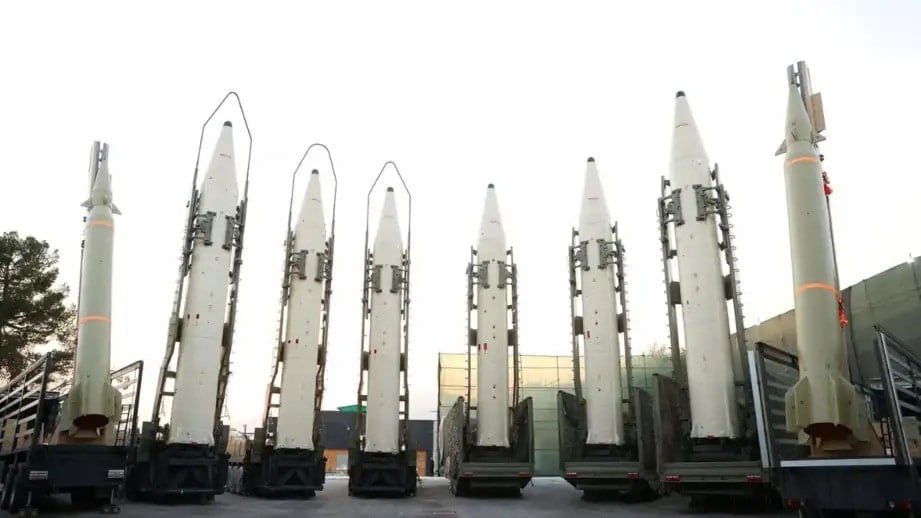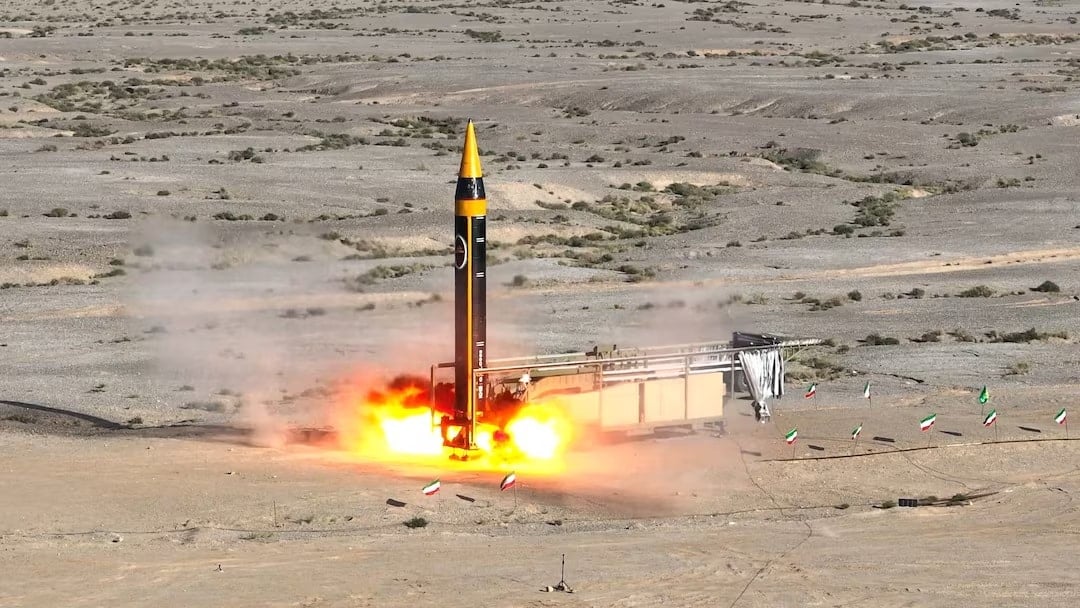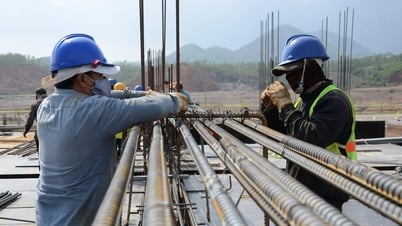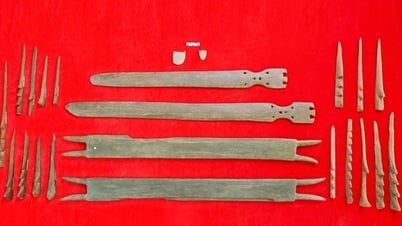What is a ballistic missile?
A ballistic missile is a self-guided strategic weapon system, launched by a rocket engine and flying on a ballistic trajectory to deliver a warhead from the launch point to a predetermined target. Ballistic missiles can carry warheads such as conventional explosives, chemical, biological or nuclear weapons. They can be launched from a variety of platforms such as aircraft, warships, submarines, as well as from fixed land-based launchers or mobile launchers.
Ballistic missiles are much harder to intercept than unmanned aerial vehicles (UAVs), and when launched in salvos, they can easily overwhelm air defense systems.
These missiles are propelled by a jet engine in the initial stage, similar to a bullet fired from a gun. They then continue flying by inertia, towards their target. When they reach their maximum speed, they enter a “ballistic” state – flying to great heights and then plunging down at extremely high speeds at very steep angles.
 |
Iran's ballistic missiles on display in Tehran. Photo: Reuters |
According to Stephan Fruehling, an expert at the Strategic and Defence Studies Centre at the Australian National University, the key to the effectiveness of ballistic missiles is their ability to maintain their trajectory after leaving the launch pad. “They fly on a predictable trajectory. They also dive at a very steep angle and at extremely high speeds, making interception extremely difficult,” he said.
Iran has focused on developing long-range missiles for decades. It also has a large arsenal of short-range missiles and potential hypersonic weapons, most of them domestically produced. Before the recent conflict, Iran had the largest and most diverse ballistic missile arsenal in the Middle East, with more than 3,000, according to US estimates.
Earlier this year, General Kenneth McKenzie, commander of the US Central Command (CENTCOM), warned about the scale and sophistication of Iran’s missiles. “Tehran’s missiles, combined with its nuclear capabilities, present a complex deterrence challenge,” he said.
What types of ballistic missiles does Iran possess?
According to experts, to reach Israel, missiles need to have a range of more than 1,000km, which means they are classified as medium-range ballistic missiles (MRBMs). According to a graphic published by Iran's semi-official ISNA news agency last year, Iran has nine types of missiles that are believed to be able to reach Israel.
The first to mention is Fateh-2, a hypersonic missile with a range of up to 1,500km at a speed of Mach 15 (about 18,375km/h). As a new version of the hypersonic missile line developed by Iran, Fattah-2 combines two technologies: Hypersonic Glide Vehicle and Hypersonic Cruise Missile. This missile uses a liquid fuel engine with the ability to adjust thrust. With a length of 12m, this hypersonic missile can carry 200kg of explosives and is capable of significantly changing its trajectory while flying to avoid defense systems.
Meanwhile, Sejjil is a medium-range, solid-fuel ballistic missile. The development of Sejjil was likely started by Iran in the late 1990s, with the design inherited from previous Iranian missile models, especially the short-range Zelzal missile. Sejjil is about 18m long, 1.25m in diameter and has a total launch weight of 23,600kg. This missile can carry a warhead weighing about 700kg, with a maximum range of about 2,000km.
Khaibar, also known as Khorramshahr-4, is a medium-range ballistic missile of the fourth generation of the Khorramshahr missile family developed by Iran. This missile is manufactured by the Ministry of Defense of the Islamic Republic of Iran, with a range of up to 2,000 km and the ability to carry a 1,500 kg warhead. The name "Khaibar" is named after the Iranian city of Khorramshahr - a place associated with the fighting during the Iran-Iraq war in the 1980s. The development and announcement of this missile is considered not only to demonstrate Iran's increasingly advanced defense technology capabilities, but also to demonstrate its ambition to strengthen its strategic deterrence in the region.
The Emad is Iran's first precision-guided long-range ballistic missile, with a range of about 1,700km and the ability to carry a 750kg warhead. It is an improved variant of the Shahab-3 missile. The Emad is Iran's long-range surface-to-surface ballistic missile equipped with a precision guidance system, capable of maneuvering during re-entry. This technology helps improve accuracy, with an error of only about 500m. This is considered a leap forward compared to previous generations. With its precision strike capability and range covering much of the Middle East, the Emad is considered a significant threat to neighboring countries and foreign military bases in the region.
The Shahab-3 is a medium-range, liquid-fueled, road-mobile ballistic missile. When carrying a 1,200kg warhead, the Shahab-3 has a range of about 1,000km. With a lighter warhead, the missile's range can be extended to 2,000km. This missile is mainly effective when attacking large-area targets. However, in later variants, Iran has integrated guidance technology, which significantly improves the accuracy of attacking targets.
The Ghadr-110, also known as the Qadr-110, is a medium-range ballistic missile. It is an improved version of the Shahab-3A (also known as the Ghadr-101). It is believed to use liquid fuel in the first stage and solid fuel in the second stage, giving it a range of about 1,500km. The Qadr-110 family of missiles is produced in three main variants: the "Qadr S" with a range of 1,350km, the "Qadr H" with a range of 1,650km, and the "Qadr F" with a range of up to 1,950km. It is one of Iran's most flexible missile systems, allowing the country to customize its strategic strike capabilities based on specific scenarios.
 |
| Image of Iran's Khorramshahr 4th generation surface-to-surface ballistic missile with a range of 2,000km. Photo: Reuters |
The Kheibar Shekan is a medium-range ballistic missile operated by the Aerospace Force of the Islamic Revolutionary Guard Corps (IRGC), with a stated range of over 1,400km. Compared to similar missiles, the Kheibar Shekan has superior maneuverability, allowing it to act as both a long-range ballistic missile and a precision strike on fixed targets. The weapon uses solid fuel and is highly maneuverable during its terminal phase, allowing it to penetrate missile defense systems. The Kheibar Shekan is also highly flexible in terms of launch platforms – it can be deployed from a variety of launchers. The main launcher is mounted on a 10-wheeled chassis, which can be camouflaged to reduce the risk of detection.
The Haj Qasem is a medium-range ballistic missile with a range of about 1,400km and a 500kg warhead. It was launched on August 20, 2020, named after the late Iranian Commander Qasem Soleimani. The Haj Qasem is considered a new generation of the Fateh-110 missile line, capable of penetrating missile defense systems. The missile is designed for precise and fast attacks, serving strategic deterrence or response campaigns in the region.
Paveh is a new long-range cruise missile developed by Iran. According to published information, this missile has a range of up to 1,650km.
Last month, Iran's defense minister also unveiled a new ballistic missile called the Qassem Basir, which is said to be able to "penetrate" air defense systems such as the US Patriot.
In addition to its medium-range ballistic missiles, Iran also has an arsenal of short-range ballistic missiles (ranges from 300 to 1,000 kilometers). Some of them (based on the Soviet Scud) are liquid-fueled, but most now use solid fuel. Many are also equipped with rudders and satellite navigation systems to improve accuracy.
Regarding the Israeli strikes, Ali Saeedi, head of the political and ideological department of the Iranian Armed Forces, confirmed that Iran used older generation missiles to retaliate against Israel, suggesting that the country's newest missiles have not yet been deployed. Iranian media quoted a source as saying that Iran's strikes on Israel used Emad, Ghadr and Kheibar Shekan medium-range ballistic missiles.
Multi-stage rocket launch system
Iran's military strategy is to integrate three types of ballistic missile launch systems: fixed, mobile and underground.
Fixed launchers are ground-based facilities that cannot be moved, making them easy to track and attack – especially through satellite imagery.
Meanwhile, mobile launchers are mounted on carefully camouflaged trailers and are constantly on the move to avoid detection. Some are “hidden” in urban or remote areas, while others are deployed in a dispersed manner in case of emergency.
Most notable is the underground launch system. Iran has developed large-scale underground complexes that allow the entire missile operation process – from transportation, fueling, assembly to launch – to be carried out entirely underground until the moment of final firing.
Iran's public disclosure of some of these underground facilities is seen as a move to deter potential attacks from Israel or Gulf states.
TRAN HOAI (synthesis)
* Please visit the International section to see related news and articles.Source: https://baodaknong.vn/cang-thang-israel-iran-kho-ten-lua-dan-dao-cua-iran-gom-nhung-gi-255841.html








































































































Comment (0)